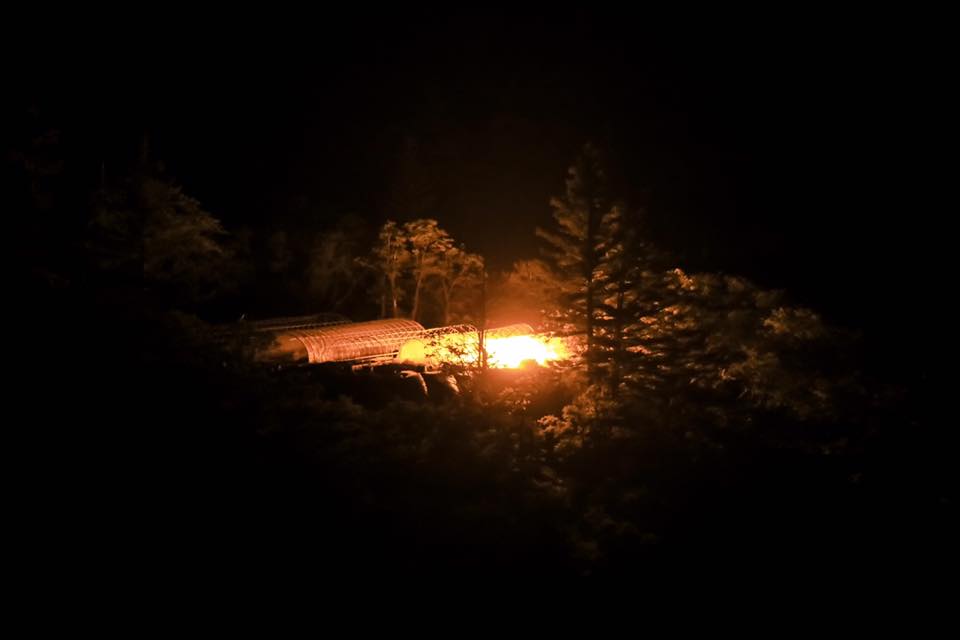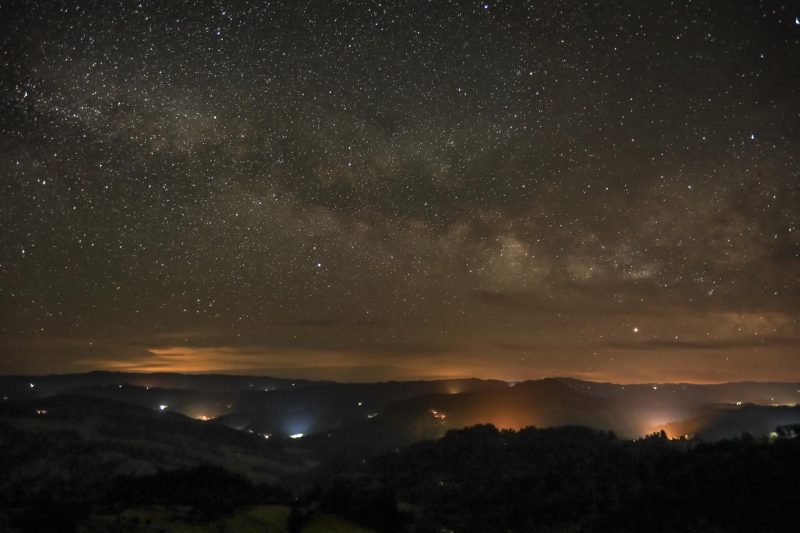So you thought cannabis was only an aesthetic blight during the day?
Just when you thought you could at least get some peace at night:
GLOWING GREENHOUSES (Glow Worms) LIGHT UP RURAL HILLS
Coming Soon to Sonoma County

[Photo of greenhouses glowing in Southern Humboldt during late April provided by a reader]Once again spring brings light to the hills of the Emerald Counties–large industrial lights that flood valleys, glow into neighbors’ windows and possibly confuse wildlife disrupting natural cycles. Rural communities complain that greenhouses constructed specifically for growing marijuana bring unwanted light into rural areas usually only lit by the stars, the moon and an occasional pinpoint of light from a distant cabin.
Concerns about the lights vary. Many rural residents are worried about environmental issues ranging from the light creating problems for animals that are nocturnal hunters to the light impacting the night skies making it more difficult to view the stars. Others are concerned about lights shining in their homes and the generators that power them disturbing their quiet neighborhoods.

Many greenhouses lighting up the night in Southern Humboldt this month. [Photo by a reader]According to Kyle Keegan, a local resident who has studied the issue, “[A]n increasing body of scientific knowledge tells us that altering the day/night cycles of environments can have a profound effect on the physiology of human and nonhuman species, as well as ecological systems.”
Keegan said, “The whole phenomenon of light pollution was not taken seriously until the last decade.” But, he said, scientist have become increasingly concerned as they’ve looked into the situation.
Keegan particularly worries that the large number of greenhouses lighting up the dark will affect nighttime pollinators such as moths. He worries that the glow will attract moths and other insects. “If they are out there chasing that light, they are not being pollinators,” Keegan explained. This can disrupt natural processes and possibly change our local ecology.
Keegan says the number of greenhouses uncovered appear to have slightly decreased in his neighborhood this year. However, in March 2013, as the following light map shows, there were few lights showing beyond those found in towns.

Light map from March 2013 for Southern Humboldt. [Screengrab from here]By last year, in 2017, light pollution had exploded.

Light map from March 2017 for Southern Humboldt. [Screengrab from here]One side effect of the uncovered greenhouse lights is that they are frequently confused with wildfires. Firefighters, most of them volunteers, are then roused from their beds and sent chasing the false fires wasting their time and their resources.

When low-lying fog hangs over a greenhouse, water droplets amplify the light. This can look like wildfire to observers and can trigger calls to bring in firefighters and inmate crews.
Possibly of the most importance to the actual grower is that having a light source provides a beacon to the greenhouse and the light itself is illegal. According to Humboldt County regulations “cultivators using artificial lighting for mixed-light cultivation shall shield greenhouses so that little to no light escapes. Light shall not escape at a level that is visible from neighboring properties between sunset and sunrise.”
According to a spokesperson for the Humboldt County Planning Department, “The Planning and Building Department line is the best contact for light complaints…”

Below is a video taken in the Salmon Creek watershed in the last couple of weeks facing towards Bear Buttes and Miranda. The orange glow to the far right is Garberville. Most of the other large lights are greenhouses.Video Player
00:0000:47
(Note: The creator of the video who doesn’t want to be named says that he attached a soundtrack that begins with the sound of an electric transformer and moves to Nasa’s Symphonies of the Planets.)
Many, if not most, greenhouse owners cover their lights but, the glow from the ones who don’t continues to frustrate rural neighborhoods.
Earlier Chapters about Greenhouse Lights:
- In Defense of the Stars: The Use of “Mixed-light” Greenhouses Is Changing our Night Skies and May Be Altering our Nocturnal Ecology
- Night Sky Lights Up During Spring in the Emerald Counties
Some issues with hoop houses
The plastic will surely tear during strong winds (ever more common now due to climate change). It will both litter the landscape as well as go into landfills. California has banned plastic grocery bags and plastic straws- this is much worse!
2) Plastic flapping in the wind is noisy.
3) Use of hoop houses over the large ‘outdoor’ cultivation area now allows 2-3 harvests/year, vs one if only outdoor. Thus water usage increases- instead of 6x more water usage per acre of vineyards, it now can be 12-18 x more water usage.
4) The additional electrical usage (even if solar) creates fire hazards in high fire risk areas.
5) With addition of electricity, these should require building permits approved by Permit Sonoma. The cannabis industry proposed in their March 2020 initiative that hoop houses not require building permits and be ag-exempt structures. This is what they will be under the new chapter 38.
6) Although ‘little to no light’ is supposed to escape, we know that enforcement is almost non-existent. We will see ‘glow worms’ at night.
7) And of course there is the visual blight to our landscapes.

Recent Comments